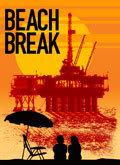 Cut off from the powerful, cleansing waves of the Pacific ocean by a massive concrete breakwater, the gentle swells that lap the Long Beach coastline are so dirty that they were recently ranked the most polluted beach water in California by the Santa Monica-based environmental group Heal The Bay. Although Mayor Bob Foster and a majority of the city council favors studying the possibility of tearing down at least part of the breakwater, such action could be years away. But city residents might be relieved to know that their civic leaders have an interim plan to clean the water.
Cut off from the powerful, cleansing waves of the Pacific ocean by a massive concrete breakwater, the gentle swells that lap the Long Beach coastline are so dirty that they were recently ranked the most polluted beach water in California by the Santa Monica-based environmental group Heal The Bay. Although Mayor Bob Foster and a majority of the city council favors studying the possibility of tearing down at least part of the breakwater, such action could be years away. But city residents might be relieved to know that their civic leaders have an interim plan to clean the water.
But then again, maybe not. The city's plan happens to call for increased pumping of ocean water at Long Beach's aging AES power plant in Alamitos Bay. And according to state marine life experts, that could end up killing a whole lot of fish
The good folks at the Long Beach Water Quality Task Force (WQTF) and AES Alamitos, a steam generating power plant located at Studebaker and Second St. have been meeting since last year about the bay's bacteria-infested water. Early last month, they proposed billing a on oil funded city trust for increased pumping at the plant to provide for greater circulation of the polluted water in Alamitos Bay. Both AES and the WQTF claim the recent increase in pollution of the city's water—as cited by Heal the Bay in its 2007 Annual Beach Report Card–is a direct result of reduced pumping at the Alamitos plant in 2006.
]
When the plant's water pumps aren't operating, they argue, the only circulation of the bay water comes from tidal surge. But thanks to the breakwater off of Long Beach's coast, there isn't a whole lot of circulation going on. Hence the solution: pump more water.
“Last year, [AES Alamitos] ran hard in July and shut down after August,” said Kevin Wattier, co-chair of the WQTF. “These patterns are consistent with the major water quality problems at Mothers Beach,” he added, referring to the child-friendly but congenitally-polluted wading beach deep inside Alamitos Bay.
At full pumping capacity, AES Alamitos can completely empty the contents of the bay twice a day. The plant is capable of pumping 852,000 gallons of water per minute and boasts an impressive cleanup rate, emptying hundreds of thousands of tons of trash from the bay each year. Tony Chavez, AES Alamitos' plant president, estimated that the increased pumping for the WQTF could cost around $2500 a day in electricity and maintenance costs. The plant will only charge the city for pumping that is done outside of its normal energy production and will only pump water, not produce electricity. The increased pumping is scheduled to begin next week and run on a contractual basis until the end of summer, which is the peak period for recreational activities in the bay.
But increased pumping doesn't just suck more trash out of the water. Marine life is also swept up in the power plant's pumps. Chavez, for his part, claims concerns about damage to marine life is misplaced. “The number [of fish harmed by pumping] is small,” he said. “Its minute, rare, for sea life to get caught in the [pumping] process.” Chavez declined to provide the number of marine animals killed in the plant's pumps each year.
But according to the California Department of Fish N Game, in 2006, when AES Alamitos was operating at only a maximum of 30 percent of pumping capacity, 1.6 billion fish were killed and nearly 24 million fish eggs were destroyed. “It's a lot of fish,” said Thomas Napoli, Staff Environmental Scientist for the California Department of Fish and Game Marine Region. “The number is really high compared to other plants in the area.”
Sarah Abramson, a scientist with Heal the Bay, says that enclosed beach areas, like Alamitos Bay, don't have as much natural replenishment from the ocean and what water they do have is constantly being recirculated, causing more fish to get caught up in the pump generated current. Plants such as the AES facilities in Huntington Beach and Redondo Beach have access to ocean water that, unlike Alamitos Bay, are not enclosed by natural bays or breakwaters.
“The increase in pumping may improve the water quality,” Abramson said. “But at the same time it would completely decimate the bay's ecosystem.”

